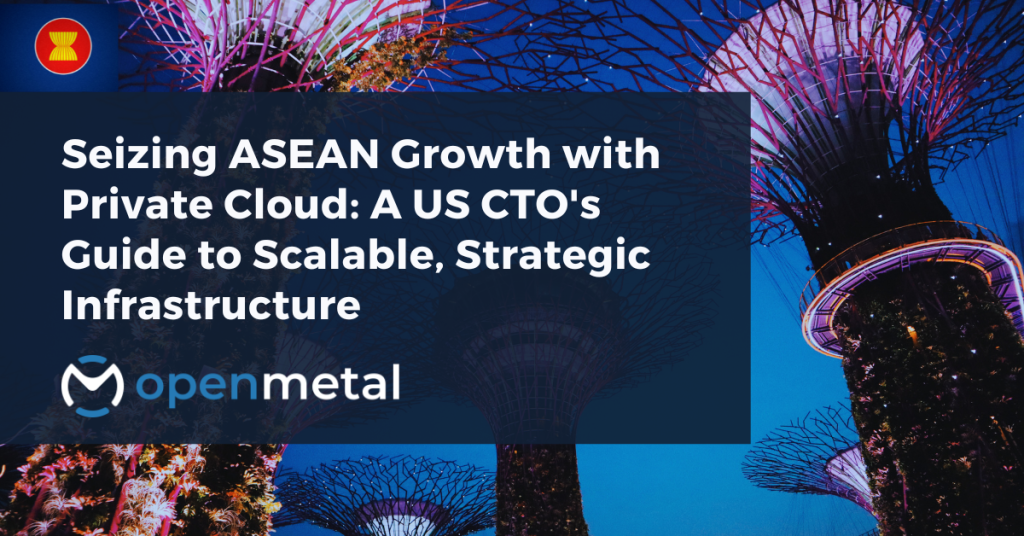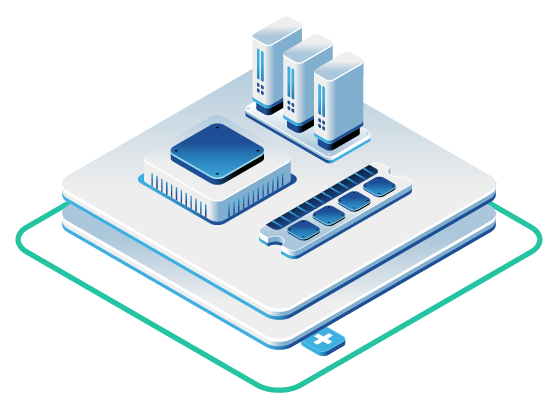
Are you looking to expand in the ASEAN region?
The OpenMetal team is standing by to assist you with scoping out a custom infrastructure expansion plan to fit your budgets and timelines.
Bottom Line Up Front: US companies expanding into ASEAN need infrastructure that balances agility, cost control, and complete operational control. While colocation ties up capital and public cloud costs spiral at scale—often leaving you at the mercy of shared resources and vendor decisions—OpenMetal’s Singapore-based private cloud offers on-demand provisioning, predictable OpEx pricing, and enterprise-grade performance with full infrastructure control, enabling you to test markets with minimal risk while retaining the flexibility and governance to scale rapidly on your terms.
The Association of Southeast Asian Nations (ASEAN) represents one of the fastest-growing digital economies in the world. With Southeast Asia’s internet economy projected to grow from $300 billion to almost $1 trillion by 2030¹, U.S. companies are eyeing ASEAN for expansion. For forward-looking CTOs and CEOs, this growth signals a strategic opportunity – but only if they can deliver digital services to the region with the right infrastructure that gives them complete control over their destiny.
In this article, we explore how infrastructure strategy—and specifically, infrastructure control—can make or break your ASEAN expansion, why an OpEx model with full operational sovereignty is a game-changer for international growth, and how OpenMetal’s private IaaS (Infrastructure-as-a-Service) offers a compelling alternative that puts you in the driver’s seat, unlike traditional colocation or public cloud in markets like Singapore.
The ASEAN Infrastructure Challenge: Speed vs. Control vs. Cost
Your infrastructure decisions for ASEAN expansion will fundamentally shape your market entry timeline and long-term economics. The ASEAN digital economy is projected to reach $330 billion by 2025², but capturing this opportunity requires infrastructure that can move at market speed while maintaining cost discipline and—critically—giving you complete control over your technology stack and operational decisions.
Consider the typical expansion scenario: your SaaS platform needs Singapore-based infrastructure to serve Southeast Asian customers with the lowest latency possible. You’re evaluating three core options, each with distinct trade-offs around control, cost, and capability:
Traditional Colocation Approach
Colocation providers offer the promise of dedicated hardware ownership and complete control over your physical infrastructure, but require 6-12 months startup time with medium-high risk of project delays³. You’ll need to procure servers, coordinate data center space, and manage complex installation processes—all while your competitors are already serving ASEAN customers. The CapEx investment locks you into specific capacity levels, creating either over-provisioning waste or under-provisioning constraints as market demand fluctuates. While you maintain full control over your hardware, the path to achieving that control is long, expensive, and inflexible.
Public Cloud Scaling Economics
Major public clouds provide immediate deployment but become significantly expensive at scale, with VM costs ranging from $69.31/month for uncommitted instances to $35.43/month with 3-year commitments⁴. More critically, international data transfer fees create ongoing cost challenges. For a deployment serving ASEAN markets with 150TB monthly bandwidth requirements, public cloud costs can exceed $60,000 monthly for VMs and data transfer combined⁴.
But the hidden cost isn’t just financial—it’s the loss of control. In public cloud environments, you’re sharing resources with countless other tenants, subject to the provider’s architectural decisions, scaling limitations, and service changes. Your infrastructure destiny is tied to their roadmap, not yours. When performance issues arise, you’re often left troubleshooting problems you can’t directly access or fix. When you need custom configurations for compliance or performance optimization, you’re constrained by what the provider offers through their standardized services.
Private Cloud Innovation: Control Without Compromise
OpenMetal’s hosted private cloud represents a paradigm shift—once set up it can deploys production-ready infrastructure in under a minute⁵, combining public cloud agility with private cloud economics and complete infrastructure control. This means you get your own dedicated OpenStack cloud environment, where every compute node, storage volume, and network configuration is yours to control and customize.

Diagram: Different cloud deployment models mapped by risk level vs startup time. Read full article here.
Unlike public cloud, where you’re a tenant on someone else’s infrastructure, OpenMetal gives you administrative access to your entire private cloud stack. You can configure networking exactly how your applications need it, implement custom security policies, optimize storage for your specific workload patterns, and integrate with existing tools without worrying about provider limitations or multi-tenant conflicts.
This represents a fundamental shift from the traditional infrastructure deployment timeline, where hosted private cloud offers 1-4 week startup times with low risk³ compared to the months-long procurement cycles of colocation—but with the crucial difference that you maintain root-level control over your environment from day one.
| Infrastructure Option | Deployment Time | Cost Structure | Control Level | Key Benefits | Primary Drawbacks |
| Traditional Colocation | 6-12 months³ | High CapEx upfront | Complete hardware control | Dedicated hardware ownership, full physical control | Complex procurement, capacity constraints, competitor advantage during setup |
| Public Cloud | 1 day | OpEx, $35-69/VM/month⁴ | Limited (shared infrastructure) | Immediate deployment | Expensive at scale ($60K+/month for ASEAN workloads)⁴, shared resources, vendor lock-in |
| OpenMetal Private Cloud | Within minutes or days³,⁵ | OpEx, ~$43/VM/month⁵ | Complete operational control | Rapid deployment + cost efficiency + full infrastructure sovereignty | Newer deployment model |
Table: Infrastructure Comparison for ASEAN Market EntryCapEx vs. OpEx – Reducing Risk While Maintaining Control in International Expansion
When planning an international expansion, one of the strategic considerations is CapEx vs. OpEx for your IT infrastructure, but equally important is the level of control you maintain over your technology destiny. CapEx – purchasing and investing in assets upfront – gives you complete ownership but requires significant upfront investment and long deployment times. OpEx – renting or paying-as-you-go for infrastructure – traditionally meant giving up control in exchange for flexibility.
Why CapEx Can Be Risky for New Markets: Committing large CapEx to build out infrastructure in an unproven market is akin to placing a big bet before you know the game. If you invest millions in hardware and facilities in ASEAN and the market response falls short, you’re left with sunk costs. Moreover, deploying CapEx infrastructure is slow (often a year or more as noted) and inflexible – not ideal when you need to iterate quickly on a go-to-market strategy while maintaining complete control over your infrastructure decisions.
The Traditional OpEx Trade-off: Public cloud is the classic OpEx model – you spin up resources on AWS/Azure/GCP as needed and shut them down when not used, turning what could have been a fixed capital cost into a variable operational cost. This is great for testing the waters initially, but as you scale, you discover the hidden costs: not just financial, but operational. You’re constrained by the provider’s multi-tenant architecture, limited in your ability to customize configurations, and increasingly dependent on their feature roadmap and pricing decisions.
The OpenMetal Advantage: OpEx with Complete Control
OpenMetal breaks the traditional trade-off between operational flexibility and infrastructure control. With OpenMetal’s hosted private cloud, you get the financial flexibility of OpEx pricing while maintaining complete administrative control over your infrastructure stack. This means you can:
- Start small and scale on your terms: Begin with minimal commitment to test ASEAN markets, then expand your private cloud resources as demand validates your strategy—all while maintaining root access and complete configuration control.
- Customize without constraints: Unlike public cloud where you’re limited to pre-configured services, OpenMetal gives you a blank slate OpenStack environment where you can implement exactly the networking, storage, and compute configurations your applications require.
- Integrate seamlessly: Your private cloud can integrate directly with existing on-premises infrastructure, hybrid cloud setups, or specific compliance requirements without working around provider limitations.
- Maintain data sovereignty: With complete control over your private cloud environment, you can implement specific data handling, encryption, and compliance policies required for ASEAN markets without relying on the provider’s standard offerings.
As one industry guide puts it, hosted private cloud is “a great way to be both flexible like a traditional public cloud and cost effective like a private cloud.”³ But more importantly, it’s a way to maintain the level of infrastructure control that enterprise applications demand while avoiding the capital risk and deployment delays of traditional private infrastructure.
Beyond Public Cloud: The Rise of Private Cloud as-a-Service with Full Operational Control
It’s a common misconception that going “private” (i.e., using dedicated infrastructure) forces you back into a CapEx model or that OpEx models require giving up infrastructure control. Thanks to innovations in cloud technology and service models, that’s no longer the case. Private Cloud as-a-Service – also known as on-demand private cloud or hosted private cloud – lets you consume private infrastructure on an OpEx basis with complete administrative access and operational control.
In other words, you get your own cloud environment on dedicated hardware, fully under your control, delivered rapidly by a provider in their data center. You maintain root access, can customize every aspect of the infrastructure, and make architectural decisions based on your requirements rather than provider limitations. This model is relatively new – OpenMetal being one of the pioneers – but growing quickly, precisely because it offers the best of all worlds: the flexibility of public cloud, the control of private infrastructure, and the cost efficiency of dedicated resources.
What Complete Infrastructure Control Means in Practice:
- Network Architecture: Design and implement your own network topologies, VLANs, security groups, and routing policies without provider restrictions
- Storage Configuration: Choose and configure storage backends, implement custom backup strategies, and optimize for your specific I/O patterns
- Security Implementation: Deploy your own security tools, implement custom monitoring, and maintain complete visibility into your infrastructure stack
- Integration Freedom: Connect directly to existing systems, implement hybrid cloud architectures, and use any tools or software your team prefers
- Performance Optimization: Tune kernel parameters, optimize resource allocation, and implement custom performance monitoring without provider interference
For CTOs and CIOs, this means you no longer have to choose between speed, cost, and control. You can have agility without the multi-tenant trade-offs. You can adopt an OpEx model without being locked into ever-increasing usage fees or giving up infrastructure sovereignty. With private cloud as-a-service, your costs become more predictable and your infrastructure is fully under your governance – a critical factor for companies concerned with compliance, data sovereignty, or performance consistency.
This approach is especially compelling in ASEAN markets like Singapore, where data sovereignty and consistent performance are important considerations. Rather than renting slices of a hyperscaler’s cloud in Singapore (and sharing infrastructure with thousands of others), you can effectively rent an entire private cloud that runs on dedicated hardware in a Singapore data center – delivered to you in a turnkey fashion with complete administrative control.
Why Singapore Matters for Your ASEAN Strategy
OpenMetal’s recent expansion into Singapore through Digital Realty’s SIN10 facility positions the company to serve growing demand for flexible, controllable infrastructure in the Asia-Pacific region⁶. Singapore’s role as a regional technology hub makes it the logical entry point for US companies targeting Southeast Asian markets, especially those requiring complete infrastructure control for compliance, performance, or integration requirements.
“We’re excited to announce our expansion into Singapore,” shares Todd Robinson, President of OpenMetal. “This marks a significant milestone in our goal to provide businesses worldwide with fast and easy access to powerful, dedicated hardware with complete operational control. The demand for flexible and scalable infrastructure in the Asia-Pacific region is quickly growing, and we are confident that our unique approach—combining rapid deployment with full infrastructure sovereignty—will be valuable to organizations in this market.”
The strategic advantage extends beyond latency optimization. Singapore’s regulatory environment supports data sovereignty requirements that many enterprises face when serving customers across Malaysia, Indonesia, Thailand, and other ASEAN markets. With OpenMetal’s private cloud, you maintain complete control over data handling, encryption policies, and compliance implementations, while the Digital Realty SIN10 facility offers compliance with SOC2, SOC3, PCI-DSS, ISO 27001, and other certifications critical for enterprise workloads⁷.
OpenStack-Powered Private Cloud: The Technical Foundation for Complete Control
OpenMetal’s private clouds are powered by OpenStack and Ceph, providing robust, mature, API-first infrastructure with zero licensing costs and complete administrative access. This technical architecture delivers several key advantages for international expansion:
Rapid Provisioning Without Compromise
Private cloud deployment can happen in as little as 45 seconds⁵, dramatically faster than traditional infrastructure procurement while maintaining enterprise-grade performance, reliability, and complete operational control. Your engineering teams can provision compute resources, storage, and networking through familiar APIs with full administrative privileges, enabling infrastructure-as-code approaches that maintain consistency across your US and ASEAN deployments while allowing complete customization for regional requirements.
Cost-Predictable Scaling with Full Control
OpenMetal’s pricing model delivers significant cost advantages at scale, with managed private cloud VMs averaging $43 monthly compared to $205 for equivalent public cloud instances⁵—and unlike public cloud, you maintain complete control over resource allocation, performance tuning, and architectural decisions. For ASEAN expansion scenarios, this translates to meaningful budget predictability combined with the ability to optimize infrastructure exactly for your workload patterns.
A 1,000 VM deployment with 150TB monthly bandwidth costs approximately $16,288 monthly on OpenMetal’s managed private cloud versus $60,450 on public cloud platforms⁴—and with OpenMetal, every one of those VMs is under your complete administrative control.
Open Source Freedom with Complete Customization
Being built on open source technologies eliminates vendor lock-in concerns while providing complete access to customize and control every aspect of your infrastructure stack. Your team maintains full administrative access to the underlying technology, with the ability to implement custom configurations, integrate with any existing tools, modify system behaviors, and maintain consistency with on-premises infrastructure if needed. Unlike proprietary public cloud services that lock you into specific implementations, OpenMetal’s open source foundation ensures you can always adapt, migrate, or integrate your infrastructure exactly as your business requires.
Real-World Economics: Public Cloud vs. Private Cloud at ASEAN Scale
The cost implications of infrastructure choices become particularly pronounced in international expansion scenarios, but the control implications are equally critical. OpenMetal’s analysis demonstrates clear tipping points where private cloud infrastructure delivers superior economics compared to public cloud alternatives⁴—while simultaneously providing complete operational control.
Consider a typical ASEAN expansion scenario with moderate scale requirements:
500 VMs with 50TB monthly bandwidth:
- Public cloud total: $28,925 monthly ($347,100 annually) + limited control
- OpenMetal managed private cloud: $11,294 monthly ($135,528 annually) + complete control
- Annual savings: $211,572 + infrastructure sovereignty
The cost differential becomes more pronounced at enterprise scale:
2,000 VMs with 300TB monthly bandwidth:
- Public cloud total: $86,260 monthly ($1,035,120 annually) + shared resources
- OpenMetal managed private cloud: $24,775 monthly ($297,300 annually) + dedicated control
- Annual savings: $737,820 + complete infrastructure control
These calculations include bandwidth costs, where public cloud egress pricing creates significant ongoing expenses for international operations, while OpenMetal’s infrastructure includes generous bandwidth allocations with predictable 95th percentile billing⁴. More importantly, every dollar spent with OpenMetal buys you dedicated resources under your complete administrative control, not shared tenancy with performance variability.
Driving Innovation with the Right Partner
“Our mission is to remove the traditional barriers to global expansion,” says Todd Robinson, President of OpenMetal. “We’ve combined the performance and security of enterprise private clouds with the on-demand convenience of cloud computing and complete operational control. The result is that a business can enter a new market like ASEAN with full confidence in their infrastructure – they get cloud agility, private cloud control, and predictable economics.”
For U.S.-based companies, having an infrastructure ally like OpenMetal who understands both cloud architecture and regional expansion challenges—while providing complete infrastructure control—can significantly accelerate go-to-market timelines and reduce both financial and operational risk.
Strategic Implementation: From Market Testing to Full Deployment with Complete Control
OpenMetal’s infrastructure model supports both cautious market entry and aggressive scaling strategies while maintaining complete operational control throughout your expansion journey. The OpEx pricing structure eliminates the CapEx risk that traditionally accompanies international infrastructure investments, while dedicated resources ensure you’re never constrained by multi-tenant limitations.
Phase 1: Market Validation with Full Control
Begin with minimal infrastructure commitment to test ASEAN market demand while maintaining complete administrative access to your environment. OpenMetal’s on-demand provisioning allows you to deploy test environments and pilot services with full customization capabilities, providing genuine market validation before substantial investment while ensuring your infrastructure can be optimized exactly for your application requirements.
Phase 2: Controlled Scaling on Your Terms
As market traction develops, add compute and storage resources incrementally while maintaining complete control over architecture decisions. The hosted private cloud model provides startup times of 1-4 weeks for additional capacity³, significantly faster than the 6-12 month timelines required by colocation, and every new resource remains under your complete administrative control.
Phase 3: Full Regional Deployment with Infrastructure Sovereignty
OpenMetal’s infrastructure supports horizontal scaling through additional cloud cores or compute nodes, enabling you to serve the full ASEAN region from the Singapore deployment while maintaining consistent performance, cost structure, and complete operational control. Your regional infrastructure remains fully integrated and under your governance, allowing seamless management across all deployments.
“Singapore is a key hub for innovation in Asia,” notes Todd Robinson. “With a presence in Digital Realty’s facility, we’re now better positioned to support the growth and success of businesses across the region with infrastructure they can completely control and customize.”
Use Cases: Who Benefits Most from ASEAN Private Cloud Infrastructure with Complete Control
OpenMetal’s Singapore deployment particularly suits US companies in several technology-forward sectors that require infrastructure sovereignty:
SaaS Platforms
Software-as-a-Service companies need reliable, low-latency infrastructure with the ability to customize performance characteristics for Southeast Asian customers. The combination of OpenStack’s mature virtualization capabilities, predictable cost structure, and complete administrative control supports both established SaaS providers and emerging platforms targeting ASEAN markets with specific performance or integration requirements.
Fintech and Financial Services
Financial technology companies require infrastructure that meets strict compliance requirements while providing complete control over security implementations and data handling. Singapore’s regulatory environment and Digital Realty’s compliance certifications, combined with OpenMetal’s infrastructure sovereignty, support fintech applications requiring SOC2, PCI-DSS, and ISO 27001 adherence with custom security configurations.
Healthcare Technology
Healthcare platforms expanding into ASEAN markets need infrastructure that supports data sovereignty requirements while maintaining complete control over sensitive healthcare data processing. Private cloud infrastructure with administrative access provides the governance needed for healthcare applications requiring custom encryption, audit trails, and compliance implementations.
E-commerce and Digital Marketplaces
Southeast Asia’s e-commerce sector is experiencing 62% growth, with gross merchandise value projected to reach $234 billion by 2025⁸. E-commerce platforms need infrastructure that can handle traffic spikes during regional shopping events while maintaining cost efficiency during normal operations—and the ability to optimize infrastructure configurations for their specific traffic patterns and integration requirements.
Making the Decision: Key Evaluation Criteria
When evaluating infrastructure options for ASEAN expansion, focus on these critical factors:
Time to Market Impact
Infrastructure deployment models range from 1-day deployment for public cloud to 12-24 months for on-premises deployment, with hosted private cloud offering 1-4 week deployment timelines³. Consider how infrastructure delays affect your competitive position in rapidly growing ASEAN markets, and whether you need complete control from day one.
Total Cost of Operations
Evaluate both direct infrastructure costs and operational overhead. Public cloud infrastructure requires ongoing FinOps management to control costs and often constrains architectural choices, while private cloud infrastructure provides predictable monthly expenses with complete customization freedom.
Control and Sovereignty Requirements
Consider your need for administrative access, custom configurations, compliance implementations, and integration flexibility. Public cloud limits your options to provider-approved services, while private cloud gives you complete freedom to implement exactly what your applications require.
Scaling Flexibility
Consider both upward and downward scaling requirements with full control maintained throughout. ASEAN market expansion often involves uncertain demand patterns, making infrastructure flexibility particularly valuable—especially when you can optimize that infrastructure exactly for your workload characteristics.
Technical Team Requirements
OpenMetal provides extensive documentation and training programs for system administrators⁵, with managed service options available for organizations without dedicated infrastructure teams—but unlike public cloud managed services, you retain complete access and control over all configurations.
The Path Forward: Getting Started with ASEAN Infrastructure
The window for capturing ASEAN digital economy growth remains wide open, but infrastructure decisions made today will determine your competitive position for years to come. With ASEAN expected to become the fourth-largest economy globally by 2030, driven by 700 million increasingly online individuals¹, the companies that establish efficient infrastructure presence early—with complete control over their technology stack—will have significant advantages.
OpenMetal’s Singapore deployment offers a compelling alternative to the traditional infrastructure trade-offs. Instead of choosing between colocation’s capital requirements and public cloud’s shared resources and scaling costs, you can access enterprise-grade infrastructure with public cloud agility, private cloud economics, and complete operational control.
For CTOs and technical executives evaluating ASEAN expansion, the question isn’t whether to establish regional infrastructure presence—it’s how to do so in a way that supports both immediate market entry and long-term scaling success while maintaining complete sovereignty over your technology decisions.
Consider conducting a pilot deployment in OpenMetal’s Singapore facility to validate both technical performance and cost projections for your specific use case while experiencing the complete infrastructure control that distinguishes private cloud from shared public cloud environments. The combination of rapid deployment, predictable costs, scaling flexibility, and infrastructure sovereignty provides a foundation that can adapt to whatever ASEAN market opportunities emerge—on your terms, under your complete control.
The ASEAN digital economy growth story is still being written. With the right infrastructure foundation—one that gives you complete control over your technology destiny—your company can be part of that narrative rather than watching from the sidelines or being constrained by vendor limitations.
Ready to expand in the ASEAN region with OpenMetal’s Singapore Data Center?
Complete the form below, and a member of our team will reach out to you soon. Please note that while we are currently accepting requests for the Singapore data center, order fulfillment will begin in October 2025.
Works Cited
- World Economic Forum. “How ASEAN is building trust in its digital economy.” January 2024. https://www.weforum.org/stories/2024/01/asean-building-trust-digital-economy/
- ASEAN Indonesia 2023. “ASEAN Digital Economy Projected to Reach US$330 Billion by 2025.” September 4, 2023. https://asean2023.id/en/news/asean-digital-economy-projected-to-reach-us330-billion-by-2025
- OpenMetal. “Cloud Deployment Models in 2024 – 6 Options for Modern Clouds.” https://openmetal.io/resources/blog/cloud-deployment-models/
- OpenMetal. “Public vs Private Cloud: A Cost Tipping Point Guide for IT Professionals.” https://openmetal.io/resources/blog/public-cloud-vs-private-cloud-cost-tipping-points/
- OpenMetal. “Hosted Private Cloud.” https://openmetal.io/platform/hosted-private-cloud/
- OpenMetal. “OpenMetal Strengthens Asia Presence with the Launch of Singapore Data Center.” April 17, 2025. https://openmetal.io/resources/blog/openmetal-strengthens-asia-presence-with-the-launch-of-singapore-data-center/
- OpenMetal. “Data Center Locations.” https://openmetal.io/about-openmetal/data-center-locations/
- Google, Temasek, Bain & Company. “e-Conomy SEA 2021: Southeast Asia enters its ‘digital decade’ as the internet economy is expected to reach US$1 trillion.” November 2021. https://www.bain.com/about/media-center/press-releases/2021/sea-economy-report-2021/







































